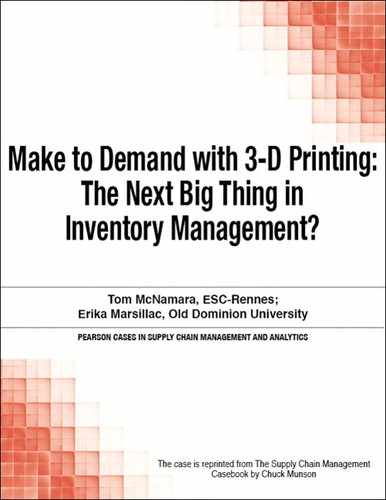Make to Demand with 3-D Printing: The Next Big Thing in Inventory Management?
Tom McNamara† and Erika Marsillac‡
† ESC-Rennes, Rennes, France; [email protected]
‡ Old Dominion University, Norfolk, Virginia, USA; [email protected]
Imagine that you are the manager of a high-volume continuous process factory. Suddenly, your production line goes down because a machine fails. A technician tells you that the problem is a critical small part that needs to be replaced. You used to keep plenty of these parts on hand for just such an emergency. But since your company instituted a “lean” inventory policy in order to reduce the amount of material you keep on hand, you no longer have any spares. Ordering a replacement part will take several weeks, and the cost of lost production due to the line being down will run into the millions of dollars. Wouldn’t it be great if there was a way to “magically” produce the part you needed? Well, soon there might be.
A technique called 3-D printing (otherwise known as additive manufacturing) could provide just such a solution. It is a fairly simple concept. First, design specifications for the item you need are fed into a 3-D printer (which often looks and works just like regular document printer). Next, the work piece gets built as layers are carefully and methodically “printed” onto a flat surface, repeatedly, until a fully formed three dimensional item appears, like adding layers to a cake. The layer materials can be as diverse as powdered metal, liquid plastic, or even specific metal-based inks, which are used to print and build electronic circuits.
The concept of 3-D printing is not new. Since the late 1980s, it has been used to manufacture individual samples or prototypes, mostly for demonstration purposes. But thanks to improved technology, lower costs, faster printing speeds and better quality, 3-D printing is finding its way into a whole host of new applications and markets that were formerly out of reach. In many cases, 3-D printers can now make things, with the same level of quality (in some cases even better), with less material, more quickly, and with fewer constraints than traditional production methods.
Traditional production of metal or plastic commercial items uses industrial dies, which stamp out what you need from a piece of metal, or injection molds, which are filled with liquid plastic to form a shape as they dry. Another traditional way to produce a commercial item is to take a block of metal and cut away at it on a lathe (otherwise known as “machining”) until it is in the shape you need. These well-proven methods can be laborious, costly, time consuming, and wasteful (for example, machining usually wastes 90% of the material being used), and quite often can produce only a limited product range. They end up requiring long, high-volume production runs to make them cost effective.
Due to the lengthy lead times that can be required to manufacture an item in these traditional ways, companies normally need to keep vast inventories of critical spare parts on hand, tying up money that could have otherwise been put to better use. The advent of 3-D printing could allow companies to put an end to this practice, drastically lowering the cost of inventory by letting manufacturers produce exactly what they need, when they need it.
The main drawback of 3-D printing, however, is still the relatively high cost of the specialized printer. Industrial 3-D printers can cost well over a $1 million, although prices are dropping fast. A top-of-the line traditional milling machine, on the other hand, can be obtained for around $50,000 (with second-hand machines in excellent condition costing a fraction of that). Also, the specialized metal and plastic materials used in 3-D printing are generally far more expensive than conventional materials. In addition, there really are no cost benefits achieved from large production runs, so 3-D printing is still best suited to low volume/high customization applications.
Despite its comparatively high cost and limited applications, 3-D printing is a growing industry, with about 28% of current production resulting in final, finished products versus a history of producing only prototypes. Sales of 3-D printed products were $1.7 billion in 2011, double what they were in 2007, and they are expected to reach $5.2 billion by 2020, according to Wohlers Associates, a consultancy. This trend should only continue as printers get faster and cheaper.
Questions
1. What are some potential drawbacks and benefits of 3-D (or additive) printing?
2. Do you believe that 3-D printing has a future? Explain.
Activity
Visit the website for 3-D Systems (production3dprinters.com). What are some of the industries benefitting from 3-D printing? What are some of the types of products being made?
Sources
“3-D printing could remake U.S. manufacturing” By Paul Davidson, USA Today, July 10, 2012. Accessed at: http://www.usatoday.com/money/industries/manufacturing/story/2012-07-10/digital-manufacturing/56135298/1.
“3D Printing Industry Will Reach $3.1 Billion Worldwide by 2016” By T.J. McCue, Forbes.com, March 27, 2012. Accessed at http://www.forbes.com/sites/tjmccue/2012/03/27/3d-printing-industry-will-reach-3-1-billion-worldwide-by-2016/.
“Additive manufacturing: Solid print” The Economist, April 21, 2012. Accessed at http://www.economist.com/node/21552892.
“Print me a phone” The Economist, July 28, 2012 Accessed at http://www.economist.com/node/21559593.
“3D Printers: Make Whatever You Want” Bloomberg Business-Week, April 26, 2012. Accessed at http://www.businessweek.com/articles/2012-04-26/3d-printers-make-whatever-you-want.
